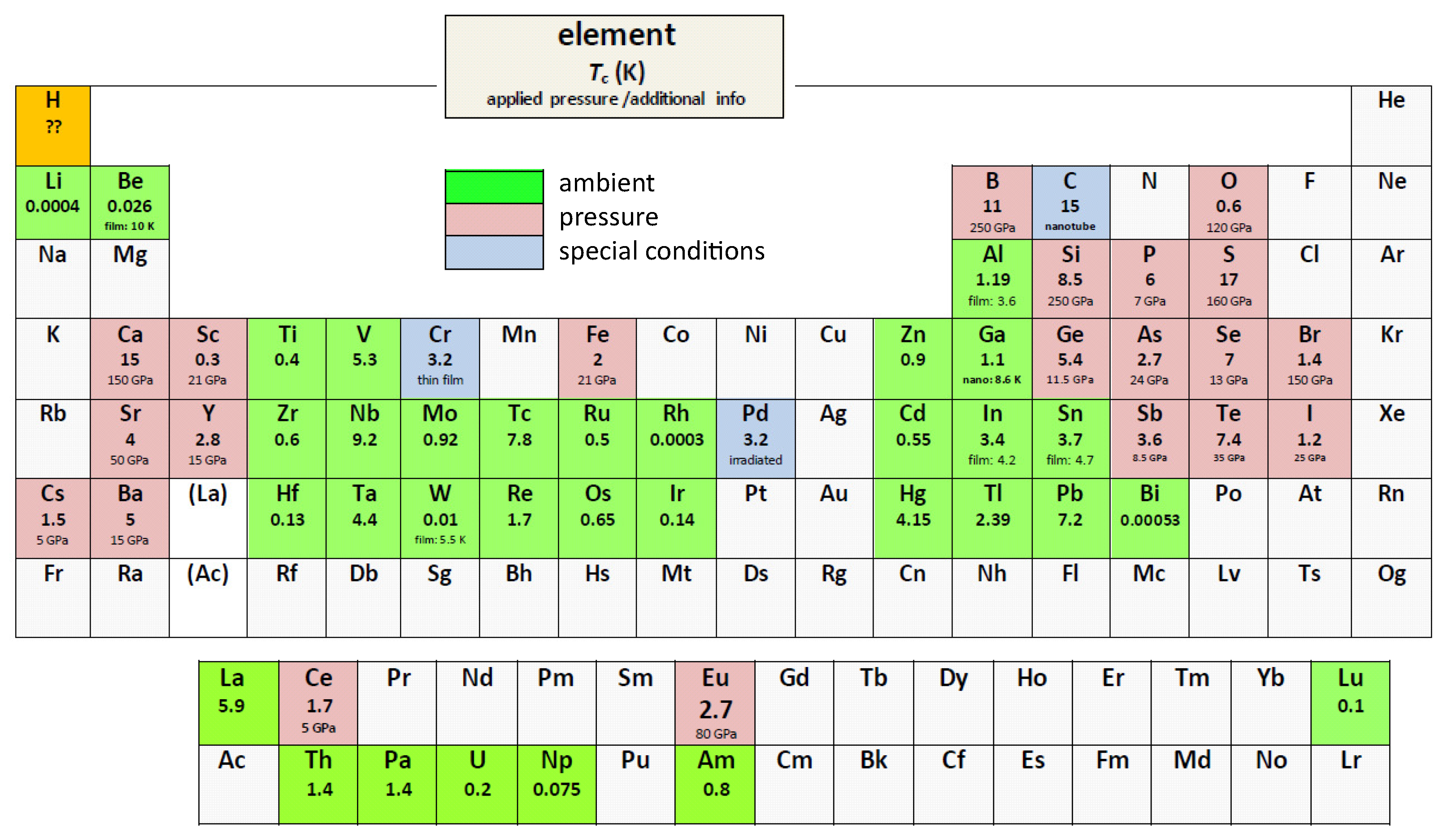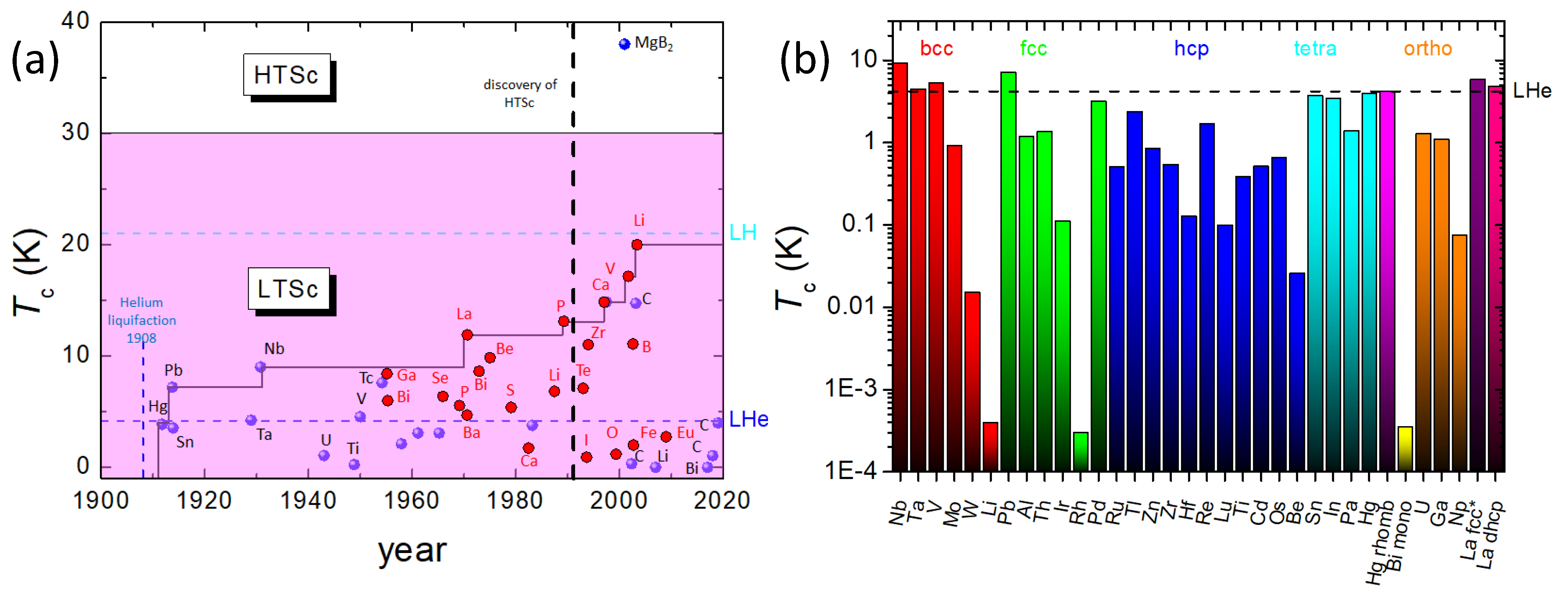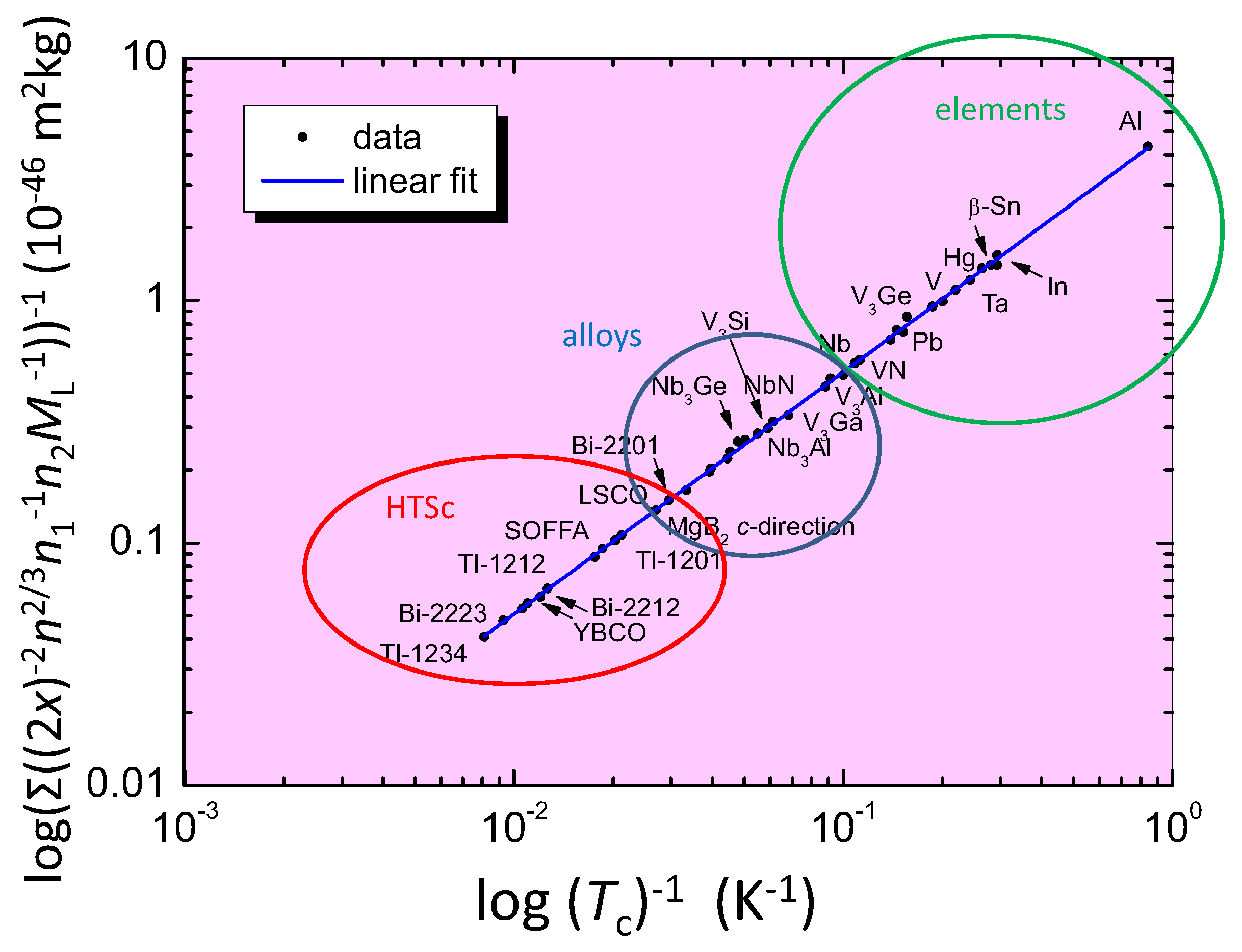Calculation of Tc of Superconducting Elements with the Roeser–Huber Formalism
Abstract
:1. Introduction
2. Principles of the Model
- (i)
- The distance x corresponds to an interatomic distance similar to the PiB approach applied in [1]. The distance x is obtained from possible symmetric paths (also called superconducting directions in the following) for the movement of the charge carrier wave within the crystal structure, as discussed below. The crystallographic data come from respective databases [26,27], which is an important issue for application of the Roeser–Huber formalism in machine-learning calculation approaches.
- (ii)
- The parameter for high- superconductor (HTSc) compounds was taken as 2. For element superconductors, is much higher as all the phononic interactions (Fermi temperature, Debye temperature, effective mass, charge carrier density) are incorporated in the parameter . In a first approximation, 1900, which corresponds closely to the mass of a proton ( 1836.15). Regarding the location of metallic superconductors in a Uemura plot ( as function of the Fermi temperature, [28,29] and denoting the Fermi velocity, m* is the effective mass) in the lower right corner with 10… 10 K, the high value for is reasonable. This significant difference between elemental metallic superconductors and the HTSc materials was also pointed out by Emery and Kievelson [30] mentioning the substantial phase rigidity of the superconducting state in, e.g., lead at all temperatures below .
- (iii)
- A first correction factor is required to account for more complex crystal structures. Atoms being close to a superconducting direction may have an influence on the moving charge carriers via the phonon interaction. Therefore, the number of atoms passed within a unit cell is counted. This correction was originally added to the parameter via:which we keep here for consistency. Regarding the definition of given above, the relation is thus incorporated in . Here, represents the number of the charge carriers and denotes the number of the near, passed atoms along each superconducting path. A correction factor can be then defined as . In case there are no (near) passed atoms, then 1.As the symmetry of the superconducting path plays an important role for our considerations, the passed atoms must be symmetrically arranged along the superconducting path, as otherwise the charge carriers would be not in phase due to the unsymmetric forces. This implies that superconductivity cannot exist in directions with unsymmetrically arranged passed atoms. As test for the influence of the passed atoms, we define a relation , with l being a distance perpendicular to the direction of the moving charge carriers. If 0.5, the passed atoms show an influence on the superconductivity and must be counted in . Here, it is important to point out that and are not free parameters, but are given from the respective crystal structure being investigated. A special case for determining will be encountered for hcp Fe under pressure as discussed below.
- (iv)
- A second correction factor is necessary to account for anisotropic superconductivity, which can even lead to so-called multimode superconductivity. The factor gives a relation between the specific directions for the charge carrier wave, , in the given crystal structure. The energy and the transition temperature are then calculated for each existing superconducting path , and the results must be summed up according to Equation (1). If one of the directions gives a reasonable value for to compare with the experimentally determined , this direction is taken as the superconducting path. However, the -values of the other directions and the complete sum of all may also have important implications as, e.g., in the case of Al, which was discussed in Ref. [3], the experimental value of is reached with 2 of the possible 4 directions in the fcc structure, but the total sum of all 4 directions is strikingly close to the increased , when measuring thin films. A similar situation is given for the energies, . may be compared to the pairing energy or energy gap as determined experimentally. Thus, all - and -values must be calculated for a given material. For most elemental superconductors, 1, in contrast to the metallic alloys NbSn or MgB, where superconducting directions can exist several times within one unit cell, as already discussed in Ref. [3].
3. Results and Discussion
- (1)
- along the space diagonal via the central atom. Thus, x is the half of this distance, so and 1.
- (2)
- corresponds to the crystal edge along a, so and 1.
- (3)
- along the diagonal in the top/bottom plane with and 4, i.e., the other two atoms in this plane and the central atoms (one of the given cell and the one of the cell below) are close enough to have an influence on the superconducting path.
- (1)
- Along the c-axis in the center of the structure with , and counts to 3.
- (2)
- Oriented along the edge with (1), and
- (3)
- In the plane between 2 not neighboring atoms with and 2.
- (1)
- Along the c-axis in the center of the structure with , and 3.
- (2)
- Oriented along the edge with (1), and
- (3)
- In the top/bottom plane between two not-neighboring atoms with and 2.
4. Conclusions
Supplementary Materials
Author Contributions
Funding
Institutional Review Board Statement
Informed Consent Statement
Data Availability Statement
Conflicts of Interest
References
- Roeser, H.P.; Hetfleisch, F.; Huber, F.M.; Stepper, M.; von Schoenermark, M.F.; Moritz, A.; Nikoghosyan, A.S. A link between critical transition temperature and the structure of superconducting YBa2Cu3O7-δ. Acta Astronaut. 2008, 62, 733–736. [Google Scholar] [CrossRef]
- Roeser, H.P.; Haslam, D.T.; Lopez, J.S.; Stepper, M.; von Schoenermark, M.F.; Huber, F.M.; Nikoghosyan, A.S. Correlation between transition temperature and crystal structure of niobium, vanadium, tantalum and mercury superconductors. Acta Astronaut. 2010, 67, 1333–1336. [Google Scholar] [CrossRef]
- Koblischka, M.R.; Roth, S.; Koblischka-Veneva, A.; Karwoth, T.; Wiederhold, A.; Zeng, X.L.; Fasoulas, S.; Murakami, M. Relation between Crystal Structure and Transition Temperature of Superconducting Metals and Alloys. Metals 2020, 10, 158. [Google Scholar] [CrossRef] [Green Version]
- Koblischka-Veneva, A.; Koblischka, M.R. (RE)BCO and the Roeser-Huber formula. Materials 2021, 14, 6068. [Google Scholar] [CrossRef]
- Flores-Livas, J.A.; Boeri, L.; Sanna, A.; Profeta, G.; Arita, R.; Eremets, M. A perspective on conventional high-temperature superconductors at high pressure: Methods and materials. Phys. Rep. 2020, 856, 1–78. [Google Scholar] [CrossRef]
- Buzea, C.; Robbie, K. Assembling the puzzle of superconducting elements: A review. Supercond. Sci. Technol. 2005, 18, R1–R8. [Google Scholar] [CrossRef]
- Buckel, W.; Kleiner, R. Supraleitung. Grundlagen und Anwendungen, 7th ed.; Wiley-VCH: Weinheim, Germany, 2013. [Google Scholar]
- Eisenstein, J. Superconducting elements. Rev. Mod. Phys. 1954, 26, 277–291. [Google Scholar] [CrossRef]
- Matthias, B.T. Chapter V: Superconductivity in the Periodic System. Prog. Low Temp. Phys. 1957, 2, 138–150. [Google Scholar]
- Roberts, B.W. Survey of superconductive materials and critical evaluation of selected properties. J. Phys. Chem. Ref. Data 1976, 5, 581–821. [Google Scholar] [CrossRef]
- Poole, C.P. (Ed.) Handbook of Superconductivity, 1st ed.; Elsever: Amsterdam, The Netherlands, 1995. [Google Scholar]
- Narlikar, A.V. Superconductors; Oxford University Press: Oxford, UK, 2014. [Google Scholar]
- Savitskii, E.M.; Baron, V.V.; Efimov, Y.V.; Bychkova, M.I.; Myzenkova, L.F. Superconducting Materials, 1st ed.; Plenum Press: New York, NY, USA; London, UK, 1973. [Google Scholar]
- Shimizu, K.; Kimura, T.; Furomoto, S.; Takeda, K.; Kontani, K.; Onuki, Y.; Amaya, K. Superconductivity in the non-magnetic state of iron under pressure. Nature 2001, 427, 316–318. [Google Scholar] [CrossRef]
- Steinle-Neumann, G.; Stixrude, L.; Cohen, R.E. Magnetim in dense hexagonal iron. Proc. Natl. Acad. Sci. USA 2004, 101, 33–36. [Google Scholar] [CrossRef] [PubMed] [Green Version]
- Roth, S. Theoretical Investigation of One-Component-Superconductors and their Relationship between Transition Temperature and Ionization Energy, Crystal Parameters and Further Parameters. Ph.D. Thesis, Institute of Space Systems, University of Stuttgart, Stuttgart, Germany, 2018. (In German). [Google Scholar]
- Nowotny, H.; Hittmair, O. Calculation of the transition temperature Tc of superconductors. Phys. Stat. Solidi B 1979, 91, 647–656. [Google Scholar] [CrossRef]
- Arita, R.; Koretsune, T.; Sakai, S.; Akashi, R.; Nomura, Y.; Sano, W. Nonempirical Calculation of Superconducting Transition Temperatures in Light-Element Superconductors. Adv. Mater. 2017, 29, 1602421. [Google Scholar] [CrossRef] [PubMed]
- Stanev, V.; Oses, C.; Kusne, A.G.; Rodriguez, E.; Paglione, J.; Curtarolo, S.; Takeuchi, I. Machine learning modeling of superconducting critical temperature. NPJ Comput. Mater. 2018, 4, 29. [Google Scholar] [CrossRef]
- Lee, D.; You, D.; Lee, D.; Li, X.; Kim, S. Machine-Learning-Guided Prediction Models of Critical Temperature of Cuprates. J. Phys. Chem. Lett. 2021, 12, 6211–6217. [Google Scholar] [CrossRef]
- Konno, T.; Kurokawa, H.; Nabeshima, F.; Sakishita, Y.; Ogawa, R.; Hosako, I.; Maeda, A. Deep learning model for finding new superconductors. Phys. Rev. B 2021, 103, 014509. [Google Scholar] [CrossRef]
- Hirsch, J.E. The London moment: What a rotating superconductor reveals about superconductivity. Phys. Scr. 2013, 89, 015806. [Google Scholar] [CrossRef] [Green Version]
- Koizumi, H. London Moment, London’s Superpotential, Nambu-Goldstein Mode, and Berry Connection from Many-Body Wave Functions. J. Supercond. Nov. Magn. 2021, 34, 1361–1370. [Google Scholar] [CrossRef]
- Rohlf, J.W. Modern Physics from α to Z0; Wiley: New York, NY, USA, 1994. [Google Scholar]
- Moritz, A. Calculation of the Transition Temperature of One-Component-Superconductors. IRS 09-S33. Master’s Thesis, Institute of Space Systems, University of Stuttgart, Stuttgart, Germany, 2009. (In German). [Google Scholar]
- ICDD. ICDD PDF Data Base. Available online: https://www.icdd.com/ (accessed on 21 November 2021).
- Materials Project Database V2019.05. Available online: https://materialsproject.org/ (accessed on 21 November 2021).
- Uemura, Y.J.; Le, L.P.; Luke, G.M.; Sternlieb, B.J.; Wu, W.D.; Brewer, J.H.; Riseman, T.M.; Seaman, C.L.; Maple, M.B.; Ishikawa, M.; et al. Basic Similarities among Cuprate, Bismuthate, Organic, Chevrel-Phase, and Heavy-Fermion Superconductors Shown by Penetration Depth Measurements. Phys. Rev. Lett. 1991, 66, 2665–2668. [Google Scholar] [CrossRef]
- Uemura, Y.J. Condensation, excitation, pairing, and superfluid density in high-Tc superconductors: The magnetic resonance mode as a roton analogue and a possible spin-mediated pairing. J. Phys. Condens. Matter 2004, 16, S4515–S4540. [Google Scholar] [CrossRef] [Green Version]
- Emery, V.J.; Kivelson, S.A. Importance of phase fluctuations in superconductors with small superfluid density. Nature 1995, 374, 434–437. [Google Scholar] [CrossRef]
- Talantsev, E.F.; Mataira, R.C.; Crump, W.P. Classifying superconductivity in Moiré graphene superlattices. Sci. Rep. 2020, 10, 212. [Google Scholar] [CrossRef] [Green Version]
- Stritzker, B. Superconductivity in irradiated palladium. Phys. Rev. Lett. 1979, 41, 1769–1773. [Google Scholar] [CrossRef]
- Gschneidner, K.A., Jr.; Pecharsky, V.K. Rare-earth elements. Encyclopedia Britannica. 17 January 2019. Available online: https://www.britannica.com/science/rare-earth-element/Properties-of-the-metals#/media/1/491579/173111 (accessed on 31 January 2022).
- Atoji, M.; Schirber, J.E.; Swenson, C.A. Crystal Structure of β-Hg. J. Chem. Phys. 1959, 31, 1628. [Google Scholar] [CrossRef]
- Mao, H.-K.; Bassett, W.A.; Takahashi, T. Effect of pressure on crystal structure and lattice parameters of iron up to 300 kbar. J. Appl. Phys. 1967, 38, 272–276. [Google Scholar] [CrossRef]
- Jaccard, D.; Holmes, A.T.; Begr, G.; Inada, Y.; Onuki, Y. Superconductivity of ϵ-Fe: Complete resistive transition. Phys. Lett. A 2002, 299, 282–286. [Google Scholar] [CrossRef] [Green Version]
- Ghosh KJ, B.; Kais, S.; Herschbach, D.R. Dimensional interpolation for metallic hydrogen. Phys. Chem. Chem. Phys. 2021, 23, 7841–7848. [Google Scholar] [CrossRef]
 = superconductor in ambient conditions,
= superconductor in ambient conditions,  = superconductor under applied pressure, and
= superconductor under applied pressure, and  = superconductor with special conditions). Given are the abbreviations of the names, the transition temperatures, , and the applied pressure or some extra info for each element. Hydrogen H is marked in orange concerning the prediction to be a room-temperature superconductor under high pressure. All data given are taken from Refs. [6,7,8,9,10,11,12,13].
= superconductor with special conditions). Given are the abbreviations of the names, the transition temperatures, , and the applied pressure or some extra info for each element. Hydrogen H is marked in orange concerning the prediction to be a room-temperature superconductor under high pressure. All data given are taken from Refs. [6,7,8,9,10,11,12,13].
 = superconductor in ambient conditions,
= superconductor in ambient conditions,  = superconductor under applied pressure, and
= superconductor under applied pressure, and  = superconductor with special conditions). Given are the abbreviations of the names, the transition temperatures, , and the applied pressure or some extra info for each element. Hydrogen H is marked in orange concerning the prediction to be a room-temperature superconductor under high pressure. All data given are taken from Refs. [6,7,8,9,10,11,12,13].
= superconductor with special conditions). Given are the abbreviations of the names, the transition temperatures, , and the applied pressure or some extra info for each element. Hydrogen H is marked in orange concerning the prediction to be a room-temperature superconductor under high pressure. All data given are taken from Refs. [6,7,8,9,10,11,12,13].



| Element | Structure | a (nm) | c (nm) | Number | x (nm) | (10 J) | (K) | |||
|---|---|---|---|---|---|---|---|---|---|---|
| Hg | rhomb. | 0.3005 | — | (1) | 0.308 | 2 | 1 | 2 | 1.811 | 4.175 |
| Hg | tetra | 0.3995 | 0.2825 | (1) | 0.3158 | 2 | 1 | 2 | 1.644 | 3.792 |
| Hg | tetra | (2) | 0.3995 | 2 | 1 | 2 | 1.028 | 2.37 | ||
| Hg | tetra | (3) | 0.4893 | 2 | 4 | 0.5 | 2.741 | 6.32 | ||
| La | fcc* | 0.3660 | 1.214 | (1) | 1.214 | 2 | 6 | 3 | 0.667 | 1.539 |
| (2) | 0.366 | 2 | 1 | 0.5 | 1.225 | 2.824 | ||||
| (3) | 0.6339 | 2 | 2 | 1 | 0.816 | 1.882 | ||||
| La | dchp | 0.3772 | 1.214 | (1) | 0.6072 | 2 | 3 | 1.5 | 1.335 | 3.078 |
| (2) | 0.3772 | 2 | 1 | 0.5 | 1.153 | 2.658 | ||||
| (3) | 0.6533 | 2 | 2 | 1 | 0.769 | 1.772 |
| Element | Structure | a (nm) | c (nm) | Number | x (nm) | (10 J) | (K) | |||
|---|---|---|---|---|---|---|---|---|---|---|
| Fe | hcp | 0.2482 | 3.978 | (1) | 0.3978 | 8 | 3 | 0.375 | 0.778 | 1.7926 |
| 21 GPa | (2) | 0.2482 | 8 | 1 | 0.125 | 0.666 | 1.5349 | |||
| (3) | 0.4299 | 8 | 2 | 0.25 | 0.444 | 1.0233 | ||||
| Fe | hcp | 0.2480 | 3.9755 | (1) | 0.3976 | 8 | 3 | 0.375 | 0.7785 | 1.7949 |
| 22.2 GPa | (2) | 0.2480 | 8 | 1 | 0.125 | 0.6685 | 1.5374 | |||
| (3) | 0.4295 | 8 | 2 | 0.25 | 0.4446 | 1.025 |
Publisher’s Note: MDPI stays neutral with regard to jurisdictional claims in published maps and institutional affiliations. |
© 2022 by the authors. Licensee MDPI, Basel, Switzerland. This article is an open access article distributed under the terms and conditions of the Creative Commons Attribution (CC BY) license (https://creativecommons.org/licenses/by/4.0/).
Share and Cite
Koblischka, M.R.; Koblischka-Veneva, A. Calculation of Tc of Superconducting Elements with the Roeser–Huber Formalism. Metals 2022, 12, 337. https://doi.org/10.3390/met12020337
Koblischka MR, Koblischka-Veneva A. Calculation of Tc of Superconducting Elements with the Roeser–Huber Formalism. Metals. 2022; 12(2):337. https://doi.org/10.3390/met12020337
Chicago/Turabian StyleKoblischka, Michael Rudolf, and Anjela Koblischka-Veneva. 2022. "Calculation of Tc of Superconducting Elements with the Roeser–Huber Formalism" Metals 12, no. 2: 337. https://doi.org/10.3390/met12020337
APA StyleKoblischka, M. R., & Koblischka-Veneva, A. (2022). Calculation of Tc of Superconducting Elements with the Roeser–Huber Formalism. Metals, 12(2), 337. https://doi.org/10.3390/met12020337






